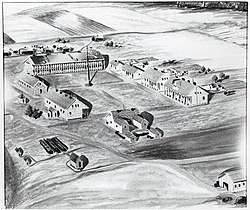Fort Ridgely | |
Minnesota State Register of Historic Places
| |
 Fort Ridgely in 1862 | |
| Location | Nicollet County, south of Fairfax, Minnesota |
|---|---|
| Coordinates | 44°27′3″N 94°43′54″W / 44.45083°N 94.73167°W |
| Built | 1853 |
| Architectural style | unpallisaded frontier fort |
| NRHP reference No. | 70000304[1] |
| Added to NRHP | December 02, 1970 |




Fort Ridgely was a frontier United States Army outpost from 1851 to 1867, built 1853–1854 in Minnesota Territory. The Sioux called it Esa Tonka.[2] It was located overlooking the Minnesota River southwest of Fairfax, Minnesota. Half of the fort's land was part of the south reservation in the Minnesota river valley for the Mdewakanton and Wahpekute tribes. Fort Ridgely had no defensive wall, palisade, or guard towers. The Army referred to the fort as the "New Post on the Upper Minnesota" until it was named for two Maryland Army Officers named Ridgely (Randolph and Lott Henderson), who died during the Mexican–American War.[3] (Many sources also cite Captain Thomas P. Ridgely as a namesake, but he died at a residence in Baltimore.)[4]
- ^ "National Register Information System". National Register of Historic Places. National Park Service. March 13, 2009.
- ^ "Lightening Blankets Story", Minnesota History Magazine, Vol. 38, Fall 1938, pp. 126–149 [1]
- ^ Upham, Warren (1920). Minnesota Geographic Names: Their Origin and Historic Significance. Minnesota Historical Society. p. 373.
- ^ Baltimore Sun, December 8, 1847, p. 2.

